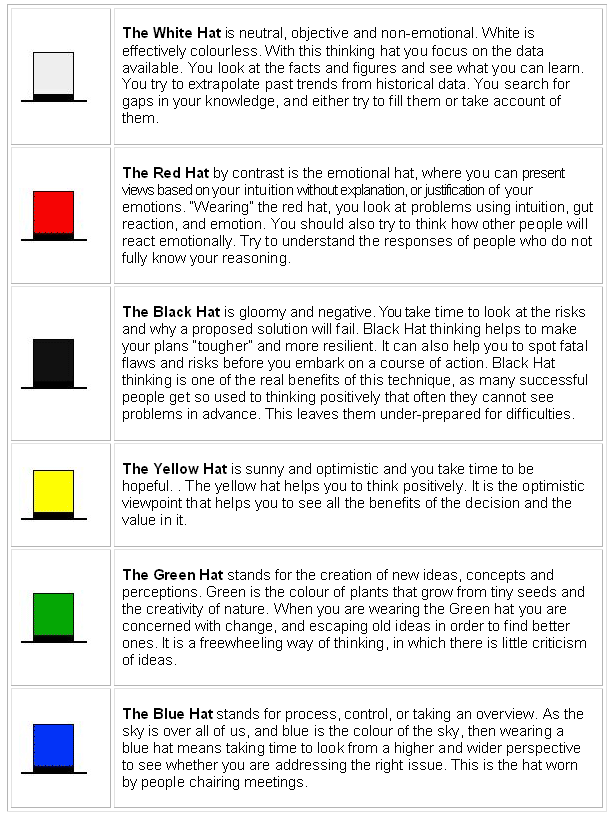Early in the 1980s Dr de Bono invented the Six Thinking Hats method which was subsequently described in his book Six Thinking Hats (1985). The method is best described as a framework for thinking.
In most organisations, corporate culture will cause most managers to adopt a specific perspective (retailers will be optimistic; insurance companies will be pessimistic; engineers will be objective; and so on). This in turns limits how management will deal with problems. The benefit of Six Thinking Hats is that one can see problems from different perspectives.
The hats are meant to be categories of thinking behavior and not of people themselves. The purpose of the hats is to direct thinking, not to classify either the thinking or the thinker. Indeed, by wearing a hat that is different from the one that one customarily wears, managers may chance upon a variety of new ideas. Wearing a hat means deliberately adopting a perspective that is not necessarily one’s own. You can use the Six Thinking Hats technique in meetings or on your own. In meetings it has the benefit of reducing the confrontations that happen when people with different thinking styles discuss the same problem.
Advertisement
Each “Thinking Hat” is a different style of thinking.

De Bono believed that the key to a successful use of the Six Thinking Hats methodology was the deliberate focusing of the discussion on a particular approach as needed during the meeting or collaboration session.
For instance, a meeting may be called to review a particular problem and to develop a solution for the problem. The Six Thinking Hats method could then be used in a sequence to first of all explore the problem, and then develop a set of solutions, and finally agree on an approach. Here is an example agenda for a typical six hats workshop:
- Step 1: Present the facts of the case.
- Step 2: Generate ideas on how the case could be handled (green hat).
- Step 3: Evaluate the merits of the ideas:
List the benefits (yellow hat);
List the drawbacks (black hat).
- Step 4: Get everybody’s gut feelings about the alternatives (red hat).
- Step 5: Summarise and adjourn the meeting (blue hat).
Because everyone is focused on a particular approach at any one time, the group tends to be more collaborative than if one person is reacting emotionally (red hat) while another person is trying to be objective (white hat) and still another person is being critical of the points which emerge from the discussion (black hat).
Advertisement
De Bono’s hats are indicative of both emotional states as well as frames of mind (i.e. perspective from which an issue is viewed). He noted: "Emotions are an essential part of our thinking ability and not just something extra that mucks up our thinking." (1985, p27) One thinking style (or hat) is not inherently "better" than another. A full, balanced team recognises the need for all hats in order for the team to consider all aspects of whatever issues they are facing.
We all use different types of thinking, usually without realising it. For example, if we are feeling pessimistic about life that will generally be the dominant thinking we apply. This limits our ability to see all the issues. Temperament is the characteristic, or habitual inclination, or mode of emotional responses that a person generally adopts.
The Humm-Wadsworth model of temperament defines seven different personality characteristic or factors. Each of the factors associates itself with certain colours.
Discuss in our Forums
See what other readers are saying about this article!
Click here to read & post comments.
6 posts so far.